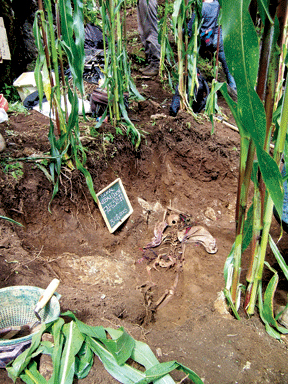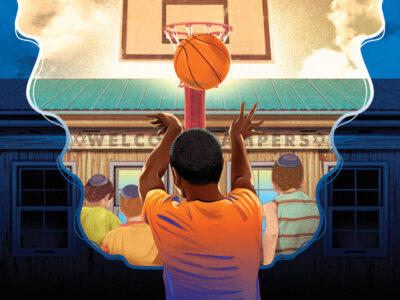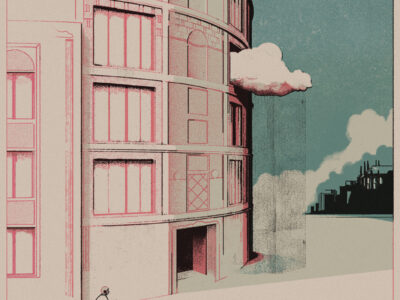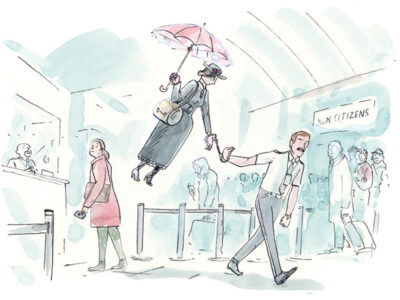
I naively imagined exhumations would be solemn affairs to honor the dead.
By Mark Gibson
Tucanal is a small village in the north of Guatemala’s Quiché department. Its adobe huts line the side of a rocky, uninviting mountain. Giggling children run through pine trees and cloud mists. Ixil farmers, machetes at their waists, tend to their fields as women slap the day’s tortillas into existence. As we neared the village, the rural song of pigs, roosters, and street dogs signaled our arrival. But we were not unexpected. We had agreed to dig, record, and try to identify those lying in unmarked graves—the victims of a 36-year civil war.
After several hours of mountain curves and mud sprays, our trucks came to a stop and I helped unload our shovels, chalkboards, tarps, and other gear before stepping out of the truck bed. I looked over our team—now assembled after months of preparations for this week of exhumations. I counted four forensic specialists, a social anthropologist, the exhumations coordinator, the forensic team director, and three volunteers, including myself.
Also with us was our Guatemalan guide, Manuel. During the group huddle I tried to focus on the discussion of our day’s work, but my attention wandered over to this chubby, round-faced man with silver-capped front teeth, and I wondered what he must be feeling to be back where he had spent his war-torn childhood.
On the ride up, Manuel and I shared a truck bed. After a brief introduction and the typical, loose Ixil-area handshake, Manuel launched into nearly an hour of uninterrupted lecture about the village of Tucanal; the area’s micro-climate, perfect for high-altitude corn; the story of the two victims to be exhumed; and how he had lived nearby in a refugee camp in the early 1980s. “Now,” he said, flashing a silver smile, “you will see it. It will take another two hours to reach the village, and then a short walk down the mountain to the grave.”
After 20 minutes of discussion with the team members, Franz, the forensic director, announced our plan. We would carry our gear down to the grave site, excavate, interview witnesses and those close to the victims for identifying information, and then hike back no more than five hours later to avoid the seasonal afternoon downpour. The trail began on a steep slope and zigzagged down until it turned off to the left along the top of a steep escarpment. In the distance, outlines of craggy mountains plunged into wide green valleys and dark clouds guaranteed another wet afternoon. Joining me at the very end of our spread-out caravan was Moncho, the social anthropologist, who swapped bad jokes with me to pass the time. After 20 minutes of slipping and falling, the only jokes we seemed to know were about the “easy hike” down to the grave.
Wandering along the trail for another five minutes, Moncho and I came across Franz. Puffing on the next link in his unbroken chain of Marlboro Reds, the Austrian frowned and told us, “I’m afraid the trail worsens a bit here.” Here? we said, peering down the steep drop to the side of the trail. Yes, he sighed and explained how Manuel thought the old path had washed out and led the others in our group down the near-vertical drop while cutting through the brush with his machete.
We secured our gear and half-climbed, half-fell down the path Manuel had cut. After an hour of slips, falls, and watching Franz, cigarette in hand, step gracefully down the path, we broke out of the forest’s shade. We were in the middle of a large cornfield rolling into the valley below. Our clothes were torn and covered in mud, and we could only guess where the gravesite was. We called out. A cheer came back to lead us to the muddiest part of the cornfield, where the team was already digging a six-feet-by-six-feet hole.
Dirt was carefully piled to one side, cornstalks were placed at another, and the forensic workers unloaded their gear and snapped photos. The others, meanwhile, rested and watched the digging from the top of a rock formation rising up a few feet above the grave. I sat next to Manuel, eating lunch with mud-covered hands, mosquitoes attacking from every direction.
As at every exhumation, I couldn’t help but feel uncomfortable watching the slow unearthing of a person’s remains. In front of me a shape was emerging from the dirt, its bones wrapped in tattered clothing, and instead of looking on, reflecting, and remembering as if in front of an open casket, I was preparing to help dig, take pictures, and categorize the evidence of an army’s brutality.
When I first began volunteering, I naively imagined exhumations would be sad, solemn affairs to honor the dead. Fitting my initial fantasy, at almost every exhumation there were the forensic workers respectfully clearing the grave, groups of older villagers watching quietly, and church leaders offering up prayers of peace. But clashing with my expectations was all the rest: Uninterested children played games of tag nearby; dogs fought and tried to mount each other; and those at work argued over the classification of molars and bicuspids.
And then, of course, there was Manuel.
With the remains of the first body, a woman, nearly uncovered and ready for removal, Moncho decided it was time for him to work. Climbing up the rock formation, he approached Manuel and, to my surprise, asked him if he were ready to be interviewed. I had photographed and helped dig alongside Manuel for much of the day, and not once did his demeanor suggest he had known the victim, let alone that she was his mother, as I was now learning.
Pulling a clipboard from his bag, Moncho explained to Manuel that he would first ask for information to identify the victim and afterwards take any testimony that he would like to share. What was your mother wearing the day she died? Did she ever break any of her bones? Did she have all of her teeth? Was she right handed? Manuel answered each question with a serious, and at times straining, effort to remember. He amazed me by how much he had captured at eight years old, and also by how little emotion he displayed as he recalled his mother’s death 23 years earlier in front of the opened grave.
In May of 1982, he explained, his family lived in a refugee community outside of Tucanal. Like many, Manuel’s family was not part of the guerrilla movement but simply trying to stay out of the path of an army that rarely differentiated between combatants and civilians, and to survive the hunger caused by its scorched-earth campaigns. “The day the army killed her,” he said, “we were out with another refugee preparing corn.” Pointing to the rock formation under our feet, he told us that it was there they hid the food and were working when the army found them.
Manuel’s mother told him to run home. Instead he hid nearby to watch the soldiers approach his mother and the other man. “I watched them talk for a few minutes,” he told Moncho, “but I didn’t understand Spanish then, so I went home when I thought they would be OK.” An hour later, Manuel and his uncle went out to investigate.
Manuel’s mother and the other man had each been shot in the chest. “When I saw them dead, I thought it was a joke, that they were both still moving,” he recalled. “But they were cold, although my mom was a little warmer than the other.” Aware of the danger of more soldiers finding them, Manuel and his uncle buried the bodies in a shallow grave.
With these last details, Manuel finished his story. Moncho shifted uncomfortably on his hard stone seat and gave Manuel his card. “If you need anything, or remember something more, don’t hesitate to contact me,” he said. And as if they had been talking about something no worse than the loss of a favored soccer team, Manuel agreed to do so with a light smile, adding that he was glad to be done before the rain arrived.
Dark storm clouds soon covered the afternoon sun and we formed teams to return. Cloudy gusts of wind surged through the trees and rain fell in cold, stinging drops, but, thankfully, several villagers pointed us to an easy trail. An hour and a half later, we arrived back in town and took refuge beneath a tarp held up by our heads and hands. Slowly, the others returned carrying gear and the garbage bag holding the brown lunch sacks filled with bones and tattered clothing. Gear was packed back into the trucks and talks were held with the village leaders until all that was left to do was wait for the rain to slow, then drive home to analyze the bones. It would be months before the bones could be reburied.
As we huddled under the tarp, I noticed that Manuel was quiet for the first time that day. He stared out at the melancholic rain and the muddy streams running down Tucanal’s central lane. Catching me watching, he opened his mouth to say something but stopped himself. After a few moments, he looked back into the rain and, flashing a slight, silver smile, remarked, “You know, it’s almost as cold and as muddy as I remember it.”
Mark Gibson C’05 is currently taking a year to work and volunteer around Latin America. You can learn more about his travels at www.gibsontravels.com.




